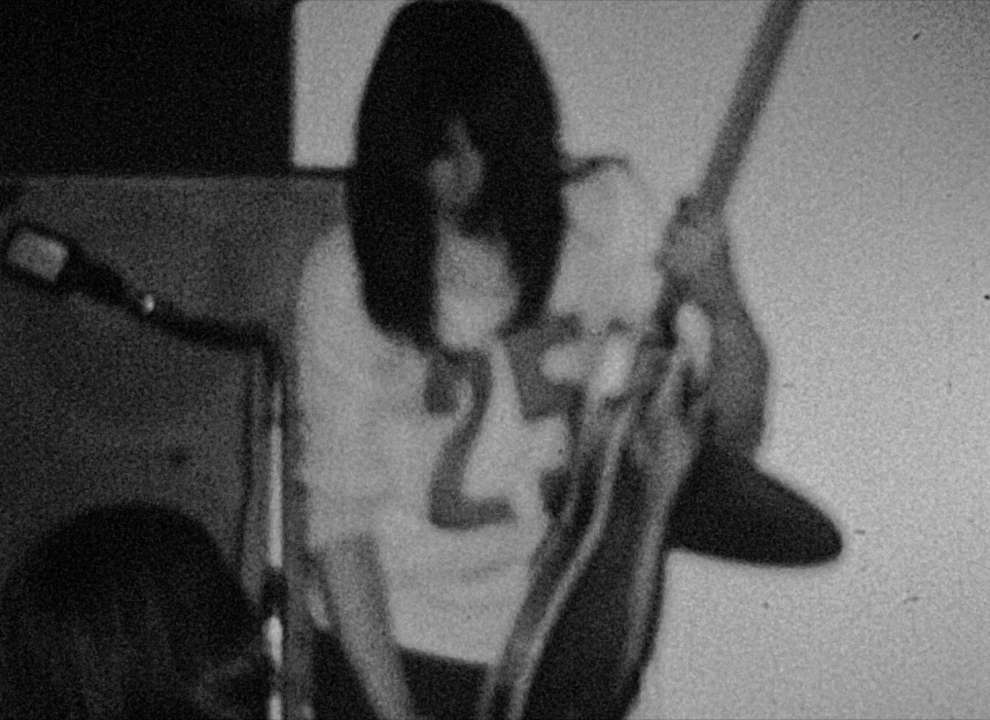Musical Visions
Music significantly influences the quality of the cinematic image. And vice versa – film can essentially transform the impression of the music. This dynamic was already reflected by the artistic avant-garde of the 1920s, but it only became the frequent foundation of art after World War II, thanks to the development of audiovisual technology. Artists started producing experimental films in collaboration with musicians, creating both official and unofficial music videos, and appropriating popular audiovisual production.
In the Czechoslovak environment of the 1970s, the experimental music scene found itself on the edges of normalisation culture, as documented in the films of artist Jan Ságl, for instance, whose recordings of underground concerts, paradoxically, lack a soundtrack. Director Ivan Tatíček also operated on the independent scene, but he found inspiration for his pioneering 1984 work Metrofilm in music videos shown on television.
A greater development of the artistically conceived music videos only took place on the Czech art scene in the early 1990s, when a transformation of the state television network and the establishment of new stations opened up the field to experiments that were not subservient to either political or commercial interests. During this period, artists working at FAMU (the Film and TV Faculty of the Academy of Performing Arts in Prague) were close to both the music scene and television studios, which led to the creation of a number of original audiovisual works. Director Niké Papadopulosová collaborated with the funk/rap group J.A.R. on their music video for the song Studna [The Well], while artist Jan Zajíček made a video titled Karamel je cukr, co už se neuzdraví [Caramel is Sugar That Will Never Heal] for the eponymous song by the alternative rap group WWW.
While those based at film schools usually have professional facilities at their disposal for both the filming and post-production of music videos, artists from art schools often work with their own means or transform pre-existing works, as is the case with Mark Ther or Pavla Sceranková.
Jan Ságl: Skála u Humpolce [Skála near Humpolec]
7 min., 1971
Show in database
Jan Ságl’s film records a concert by the rock band The Plastic People of the Universe in the village of Skála near Humpolec, where the musicians worked as lumberjacks in the early 1970s. In his film, Ságl focused almost exclusively on the facial expressions, gestures, and movements of the participants – large, expressive details with direct lighting were contrast with calmer shots of the musicians playing. Just like in other films from this period, he recorded the event on an Eumig Super-8 camera. Given the minimal editing, the film contains all the chronologically recorded material.
Ivan Tatíček: Metrofilm
8.5 min., 1984
Show in database
Although Ivan Tatíček’s Metrofilm was made on the basis of an inspiration from period music videos shown on Austrian TV, it is not a music video in the true sense of the world. The film depicts two allegorical characters, Disorientation and Order (played by David Pacholík and Ivana Málková) flowing through the spaces of the Prague underground system with repetitive movements, confronting themselves with the system of rules, procedures, and the geometric order. It thus authentically illustrates the atmosphere of the period, with its choice between social resignation, strategising in public spaces, or searching for inner freedom, which could be provided by relatively free operation in a parallel world. The music was composed to the finished film by Vladimír Helebrant, a member of the band Němý Bobeš.
Niké Papadopulosová: Studna [The Well]
4.5 min., 1996
Show in database
Niké Papadopulosová’s bachelor film, titled Studna [The Well], was inspired by an eponymous song by the band J.A.R. and a cult-status episode of the TV show Třicet případů majora Zemana [Thirty Cases of Major Zeman]. The music video consists of blended animated and live-action sequences – the artist collaborated closely with members of the group for the latter. The animated segments were mostly created by transforming shots from the original TV series using VIDOX technology, with the artist drawing on the images by hand and then re-recording them. The horror-film plot was thus transformed into a humorous pastiche whose dynamics are underlined by fast edits and improvised performances by members of J.A.R.
Mark Ther: Burger und Ther
3.5 min., 2004
Show in database
The film was made by Mark Ther in 2004 during his studies in New York, along with his Dutch classmate Gebrand Burger. They made it together during the course of a single day without having prepared a script in advance. The sound was created in post-production. This improvisation accompanied by adopted popular songs copies the form of the music video. The choreography of the dance steps, the two artists’ legs, the sound of a chair turning, or Mark Ther’s highly staged operatic singing were created as an experimental cross-section through the sonic and musical component with improvised scenes.
Pavla Sceranková: Krása [Beauty]
1 min., 2000
Show in database
The short video Krása [Beauty] was created as a final exam work during Pavla Sceranková’s studies at the Academy of Fine Arts in Prague. Detailed shots of drops of oil rotating in water allow their structure and rhythmical movement to come to the fore, which is accented by the work’s musical component. In its original version, the work was accompanied by a fragment from Einstürzende Neubauten song Beauty, but due to the difficulty of acquiring the copyright to the original song, the artist made a second version with original musical accompaniment. This work is one of the first audiovisual pieces by Pavla Sceranková.

